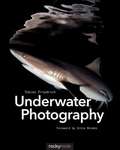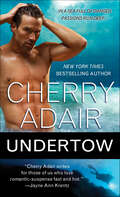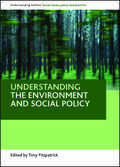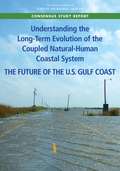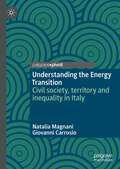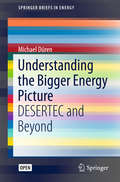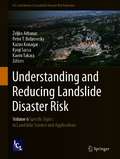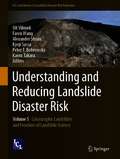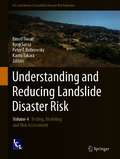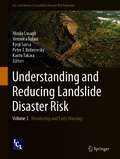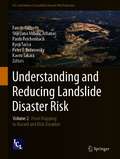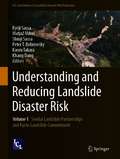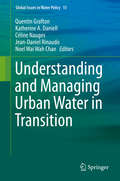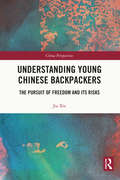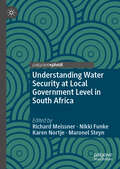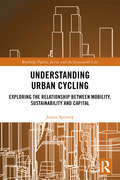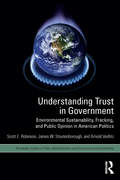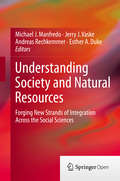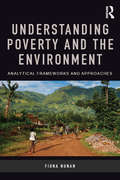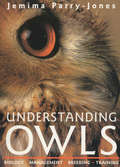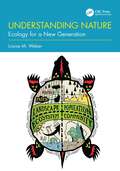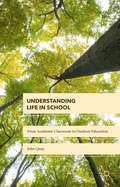- Table View
- List View
Underwater Photography
by Tobias FriedrichUnderwater photography is a fascinating pursuit for those who aspire to capture the magical world found within our oceans and bring it to the surface. In this book, award-winning photographer Tobias Friedrich teaches us how to create stunning underwater images, covering everything from the equipment needed, to creating powerful compositions, to processing the final image. He uses case studies to show how his own images were created, and provides detailed explanations for specific techniques that can be applied to your very next dive.The text is supported by images from some of the most beautiful diving areas on Earth. Also included are countless tips and tricks for the beginner and intermediate photographer.Topics include:Choosing the right equipmentComposing your imagesWide-angle photographyMacro photographyImage editingCase studiesDiagrams of shooting positionsAn added bonus is the 22-page Guest Gallery featuring images by some of today's most recognized names in underwater photography, including Ernie Brooks, Alex Mustard, Richard Salas, Imran Ahmad, and Eric Cheng.The abundance of breathtaking underwater images contained in this book is sure to inspire you to plan your next dive.Foreword by Ernie Brooks.
Underwater Dogs
by Seth CasteelThe exuberant, exhilarating photographs of dogs underwater that have become a sensationFrom the water's surface, it's a simple exercise: a dog's leap, a splash, and then a wet head surfacing with a ball, triumphant. But beneath the water is a chaotic ballet of bared teeth and bubbles, paddling paws, fur and ears billowing in the currents. From leaping lab to diving dachshund, the water is where a dog's distinct personality shines through; some lounge in the current, paddling slowly, but others arch their bodies to cut through the water with the focus and determination of a shark. In more than eighty portraits by award-winning pet photographer and animal rights activist Seth Casteel capture new sides of our old friends with vibrant underwater photography that makes it impossible to look away. Each image bubbles with exuberance and life, a striking reminder that even in the most loveable and domesticated dog, there are more primal forces at work. In Underwater Dogs, Seth Casteel gives playful and energetic testament to the rough-and-tumble joy that our dogs bring into our lives.
Underwater Art (Fountas & Pinnell Classroom, Guided Reading Grade 4)
by Jacqueline AdamsART TO THE RESCUE One of the largest coral reef systems in the world was in danger of being damaged beyond repair. The solution? A unique museum, dreamed up by an environmentalist, a businessman, and an artist, all working together. NIMAC-sourced textbook
Undertow (Cutter Cay #1)
by Cherry AdairThe New York Times–bestselling author “returns to her romantic suspense roots with an underwater treasure hunt that is thrilling and hazardous!” (Romantic Times, 4.5 stars)She takes the plunge.Teal Williams is content with her career as a ship’s master mechanic—until Zane Cutter, the “Casanova of the Caribbean,” makes her an offer she can’t refuse: to climb on board with him for a real-life treasure hunt. Teal must help him dredge up a shipwrecked vessel containing an abundance of gold, silver, and emeralds—and she’ll claim part of the prize.He’s blown off course.Zane needs a mechanic—not a lover—and Teal, who can also dive, is perfect for the job. So it suits him just fine that Teal is completely immune to his charms . . . or so he tells himself. But with a deadly enemy in their midst—one who’s silently edging closer—Zane and Teal sink into troubled waters. Trapped in the middle of a perilous sea, they have no one to turn to but each other as they face down a danger that runs unfathomably deep—and a passion that runs even deeper . . .“Undertow is the beginning of an exciting and witty new series enriched with fun characters and action-packed drama. I literally could not put it down!” —Fresh Fiction“Grips readers and never slows down as the protagonists struggle with perils including to their hearts with every nautical mile they sail. Fast-paced, Cherry Adair opens her Cutter Salvage series with a strong sea saga.” —Genre Go Round Reviews
Understanding the environment and social policy (Understanding Welfare: Social Issues, Policy and Practice)
by Tony FitzpatrickBringing together leading experts, this textbook explores the key social, political, economic and moral challenges that environmental problems pose for social policy in a global context. Combining theory and practice with an interdisciplinary approach, the book reviews the current strategies and policies and provides a critique of proposed future developments in the field. Understanding the environment and social policy guides the reader through the subject in an accessible way using chapter summaries, further reading, recommended webpages, a glossary and questions for discussion. Providing a much-needed overview, the book will be invaluable reading for students, teachers, activists, practitioners and policymakers.
Understanding the Long-Term Evolution of the Coupled Natural-Human Coastal System: The Future Of The U. S. Gulf Coast
by Engineering Medicine National Academies of SciencesThe U.S. Gulf Coast provides a valuable setting to study deeply connected natural and human interactions and feedbacks that have led to a complex, interconnected coastal system. The physical landscape in the region has changed significantly due to broad-scale, long-term processes such as coastal subsidence and river sediment deposition as well as short-term episodic events such as hurricanes. Modifications from human activities, including building levees and canals and constructing buildings and roads, have left their own imprint on the natural landscape. This coupled natural-human coastal system and the individual aspects within it (physical, ecological, and human) are under increased pressure from accelerating environmental stressors such as sea level rise, intensifying hurricanes, and continued population increase with its accompanying coastal development. Promoting the resilience and maintaining the habitability of the Gulf Coast into the future will need improved understanding of the coupled natural-human coastal system, as well as effective sharing of this understanding in support of decision-making and policies. Understanding the Long-term Evolution of the Coupled Natural-Human Coastal System presents a research agenda meant to enable a better understanding of the multiple and interconnected factors that influence long-term processes along the Gulf Coast. This report identifies scientific and technical gaps in understanding the interactions and feedbacks between human and natural processes, defines essential components of a research and development program in response to the identified gaps, and develops priorities for critical areas of research.
Understanding the Energy Transition: Civil society, territory and inequality in Italy
by Natalia Magnani Giovanni CarrosioThe transformation of the dominant model of centralized energy production from fossil fuels to renewable energies is at the center of the public and scientific debate, as well as the subject of national and European policies, as it is connected to highly topical issues such as climate change, emissions reduction and natural disasters, security of supply and sustainability of the current economic development model.Up to now this topic has been mainly addressed by the economic and engineering sciences, with a research focus on the hardware rather than on the human and social software.However, energy systems, and the possibilities of change, are not only economic or technological but involve also patterns of social life, representations, organizational models and relational structures. In order to generate the social preconditions for the transition to a low-emission society, focused on a growing production of energy from renewable sources and on a greater sustainability of consumption, it is therefore urgent to reaffirm the centrality of a sociological approach to energy.This book focused on three core research areas which are crucial to understand what is at stake with the energy transition: conflicts over the construction and location of renewable energy production plants; collective action on renewable sources that promote a new model of energy system in which consumers are also producers; and the social-territorial impact of energy policies.
Understanding the Bigger Energy Picture: DESERTEC and Beyond (SpringerBriefs in Energy)
by Michael DürenThis book is open access under a CC BY 4.0 license.This book focuses on the global cycles of energy, water and carbon, which are not only the essentials of our main energy carriers, the fossil fuels, but are also the building blocks of life. The book offers an overview of the basic scientific facts and relationships that are needed to understand today’s energy generation and use, how they relate to global climate, the water cycle and other resources, and the complexities of energy policy. Building on the work of the Desertec project, it presents the main technological options that we will have in a world after the “Energiewende” and presents the possible future solutions for a sustainable world. The book is written in an engaging, descriptive style that can be understood by those without specific knowledge of science or economics and allows readers to form their own conclusions. Controversy rages over energy problems, climate change and their possible solutions. Expressions like “climate deniers”, “renaissance of nuclear energy”, “stop the war on coal”, and “Energiewende now” represent a diversity of opinions that divide our society and political leaders. This book shows the reader the whole energy picture and how it is part of the wider global problems of overpopulation and uncontrolled economies in a world of limited resources.
Understanding and Reducing Landslide Disaster Risk: Volume 6 Specific Topics in Landslide Science and Applications (ICL Contribution to Landslide Disaster Risk Reduction)
by Peter T. Bobrowsky Kyoji Sassa Željko Arbanas Kaoru Takara Kazuo KonagaiThis book is a part of ICL new book series “ICL Contribution to Landslide Disaster Risk Reduction” founded in 2019. Peer-reviewed papers submitted to the Fifth World Landslide Forum were published in six volumes of this book series. This book contains the following parts:• Impact of Large Ground Deformations near Seismic Faults on Critically Important Civil Infrastructures• Recent Progress in the Landslide Initiating Science• Earth Observation and Machine Learning in Landslide Science• General Landslide StudiesProfessor Željko Arbanas is the Vice President of International Consortium on Landslides. He is a Professor of Faculty of Civil Engineering, University of Rijeka, Croatia. He is the Assistant Editor-in-Chief of International Journal Landslides.Professor Peter Bobrowsky is the President of International Consortium on Landslides. He is a Senior Scientist of Geological Survey of Canada, Ottawa, Canada.Professor Kazuo Konagai is Professor Emeritus at the University of Tokyo and Principal Researcher at the ICL Headquarters. He serves as the Secretary-General of the Fifth World Landslide Forum.Professor Kyoji Sassa is the Founding President and the Secretary-General of the International Consortium on Landslides (ICL). He has been the Editor-in-Chief of International Journal Landslides since its foundation in 2004.Professor Kaoru Takara is the Executive Director of International Consortium on Landslides. He is a Professor and Dean of Graduate School of Advanced Integrated Studies (GSAIS) in Human Survivability (Shishu-Kan), Kyoto University.
Understanding and Reducing Landslide Disaster Risk: Volume 5 Catastrophic Landslides and Frontiers of Landslide Science (ICL Contribution to Landslide Disaster Risk Reduction)
by Peter T. Bobrowsky Fawu Wang Alexander Strom Kyoji Sassa Vít Vilímek Kaoru TakaraThis book is a part of ICL new book series “ICL Contribution to Landslide Disaster Risk Reduction” founded in 2019. Peer-reviewed papers submitted to the Fifth World Landslide Forum were published in six volumes of this book series. This book contains the followings:Part I with topics is mainly about landslides and earthquakes; landslide dams and outburst floods; catastrophic large-scale landslides in mountainous regions.Part II with topics is mainly about impact of climate change; loess landslides; mapping, monitoring and modeling of landslides; stabilization and mitigation; application of new technology in landslide studies.Prof. Vít Vilímek is the vice-president of the International Consortium on Landslides (ICL) and a member of the evaluation committee, Editor-in-Chief of the university journal AUC Geographica and Associate Editor-in-Chief of the international journal Geoenvironmental Disasters. He is a Professor of Physical Geography at Charles University, Prague, Czech Republic.Prof. Fawu Wang is the President of the International Consortium on Geo-disaster Reduction (ICGdR) and the Editor-in-Chief of the international journal Geoenvironmental Disasters. He is a Professor at the School of Civil Engineering, Tongji University, China.Dr. Alexander Strom is a chief expert at the Geodynamics Research Center LLC, Moscow, Russia. He is also an Adjunct Professor at Chang’an University, Xi’an, China, Visiting Professor at SKLGP, Chengdu, China, and an alternative representative of the JSC “Hydroproject Institute” in ICL.Prof. Kyoji Sassa is the Founding President and the Secretary-General of the International Consortium on Landslides (ICL). He has been the Editor-in-Chief of International Journal Landslides since its foundation in 2004.Prof. Peter Bobrowsky is the President of the International Consortium on Landslides. He is a Senior Scientist of Geological Survey of Canada, Ottawa, Canada.Prof. Kaoru Takara is the Executive Director of the International Consortium on Landslides. He is a Professor and Dean of Graduate School of Advanced Integrated Studies (GSAIS) in Human Survivability (Shishu-Kan), Kyoto University.
Understanding and Reducing Landslide Disaster Risk: Volume 4 Testing, Modeling and Risk Assessment (ICL Contribution to Landslide Disaster Risk Reduction)
by Peter T. Bobrowsky Kyoji Sassa Binod Tiwari Kaoru TakaraThis book is a part of ICL new book series “ICL Contribution to Landslide Disaster Risk Reduction” founded in 2019. Peer-reviewed papers submitted to the Fifth World Landslide Forum were published in six volumes of this book series. This book contains the followings:• Five keynote lectures• Recent development in physical modeling of landslides• Recent development in numerical modeling of landslides• Recent development in soil and rock testing techniques, application and analysis methods• Recent advancements in the methods of slope stability and deformation analyses• Recent development in disaster risk assessmentProf. Binod Tiwari is a Vice President of the International Consortium on Landslides (ICL). He is the Associate Vice President for research and sponsored project and Professor of civil and environmental engineering at the California State University, Fullerton, California, USA.Prof. Kyoji Sassa is the Founding President and the Secretary-General of the International Consortium on Landslides (ICL). He has been the Editor-in-Chief of International Journal Landslides since its foundation in 2004.Prof. Peter Bobrowsky is the President of the International Consortium on Landslides. He is a Senior Scientist of Geological Survey of Canada, Ottawa, Canada.Prof. Kaoru Takara is the Executive Director of the International Consortium on Landslides. He is a Professor and Dean of Graduate School of Advanced Integrated Studies (GSAIS) in Human Survivability (Shishu-Kan), Kyoto University.
Understanding and Reducing Landslide Disaster Risk: Volume 3 Monitoring and Early Warning (ICL Contribution to Landslide Disaster Risk Reduction)
by Peter T. Bobrowsky Kyoji Sassa Nicola Casagli Kaoru Takara Veronica TofaniThis book is a part of ICL new book series “ICL Contribution to Landslide Disaster Risk Reduction” founded in 2019. Peer-reviewed papers submitted to the Fifth World Landslide Forum were published in six volumes of this book series. This book contains the followings:• One theme lecture and one keynote lecture• Monitoring and remote sensing for landslide risk mitigation, including one keynote lecture• Landslide early warning systems, forecasting models and time prediction of landslidesProf. Nicola Casagli is a Vice President and President-elect of the International Consortium on Landslides (ICL) for 2021–2023. He is Professor of engineering geology at the Department of Earth Sciences, University of Florence, and President of the National Institute of Oceanography and Applied Geophysics – OGS, Trieste, Italy.Dr. Veronica Tofani is an Associate Professor at the Department of Earth Sciences, University of Florence, and Program Coordinator of the UNESCO Chair on Prevention and Sustainable Management of Geo-hydrological hazards, University of Florence.Prof. Kyoji Sassa is the Founding President and the Secretary-General of the International Consortium on Landslides (ICL). He has been the Editor-in-Chief of International Journal Landslides since its foundation in 2004.Prof. Peter Bobrowsky is the President of the International Consortium on Landslides. He is a Senior Scientist of Geological Survey of Canada, Ottawa, Canada.Prof. Kaoru Takara is the Executive Director of the International Consortium on Landslides. He is a Professor and Dean of Graduate School of Advanced Integrated Studies (GSAIS) in Human Survivability (Shishu-Kan), Kyoto University.
Understanding and Reducing Landslide Disaster Risk: Volume 2 From Mapping to Hazard and Risk Zonation (ICL Contribution to Landslide Disaster Risk Reduction)
by Peter T. Bobrowsky Kyoji Sassa Fausto Guzzetti Kaoru Takara Snježana Mihalić Arbanas Paola ReichenbachThis book is a part of ICL new book series “ICL Contribution to Landslide Disaster Risk Reduction” founded in 2019. Peer-reviewed papers submitted to the Fifth World Landslide Forum were published in six volumes of this book series. This book contains the followings:• Keynotes• Landslide detection, recognition and mapping• Landslide susceptibility assessment and modelling• Landslide size statistics and temporal modelling• Data and information for landslide disaster mitigation• Vulnerability to landslides of people, communities and the built environmentDr. Fausto Guzzetti is General Director of Office III – Technical and Scientific Activities for Risk Forecasting and Prevention, Department of Civil Protection, Italian Presidency of the Council of Ministers, on leave from the Italian National Research Council.Prof. Snježana Mihalić Arbanas is a Full Professor of the Faculty of Mining, Geology and Petroleum Engineering of the University of Zagreb, Croatia. She is the Chair of ICL Network Committee.Paola Reichenbach is a Senior Researcher of the Research Institute for Geo-Hydrological Protection, an institute of the Italian National Research Council (IRPI-CNR), Perugia, Italy.Prof. Kyoji Sassa is the Founding President and the Secretary-General of the International Consortium on Landslides (ICL). He has been the Editor-in-Chief of International Journal Landslides since its foundation in 2004.Prof. Peter Bobrowsky is the President of the International Consortium on Landslides. He is a Senior Scientist of Geological Survey of Canada, Ottawa, Canada.Prof. Kaoru Takara is the Executive Director of the International Consortium on Landslides. He is a Professor and Dean of Graduate School of Advanced Integrated Studies (GSAIS) in Human Survivability (Shishu-Kan), Kyoto University.
Understanding and Reducing Landslide Disaster Risk: Volume 1 Sendai Landslide Partnerships and Kyoto Landslide Commitment (ICL Contribution to Landslide Disaster Risk Reduction)
by Peter T. Bobrowsky Kyoji Sassa Matjaž Mikoš Khang Dang Kaoru Takara Shinji SassaThis book is a part of ICL new book series “ICL Contribution to Landslide Disaster Risk Reduction” founded in 2019. Peer-reviewed papers submitted to the Fifth World Landslide Forum were published in six volumes of this book series. This book contains the followings:• Four Forum lectures and one award paper• Sendai Landslide Partnerships, Kyoto Landslide Commitment, and International Programme on Landslides.• Landslide-induced tsunamis• Landslides at UNESCO designates sites and contribution from WMO, FAO, and IRDR• Education and Capacity Development for Risk Management and Risk GovernanceProf. Kyoji Sassa is the Founding President and the Secretary-General of International Consortium on Landslides (ICL). He has been the Editor-in-Chief of International Journal Landslides since its foundation in 2004.Prof. Matjaž Mikoš is the Vice President of International Consortium on Landslides and Vice President of Slovenian Academy of Engineering. He is a Professor and Dean of Faculty of Civil and Geodetic Engineering, University of Ljubljana, Slovenia.Dr. Shinji Sassa is Head of Soil Dynamics Group and Research Director of International Research Center for Coastal Disasters, Port and Airport Research Institute, National Institute of Maritime, Port and Aviation Technology, Japan.Prof. Peter Bobrowsky is the President of International Consortium on Landslides. He is a Senior Scientist of Geological Survey of Canada, Ottawa, Canada.Prof. Kaoru Takara is the Executive Director of International Consortium on Landslides. He is a Professor and Dean of Graduate School of Advanced Integrated Studies (GSAIS) in Human Survivability (Shishu-Kan), Kyoto University.Dr. Khang Dang is the Secretary General of the Fifth World Landslide Forum. He also serves as the Research Promotion Officer of ICL and a Lecturer at the University of Science, Vietnam National University, Hanoi.
Understanding and Managing Urban Water in Transition
by Katherine A. Daniell Jean-Daniel Rinaudo Quentin Grafton Céline Nauges Noel Wai Wah ChanThis book examines changes and transitions in the way water is managed in urban environments. This book originated from a joint French-Australian initiative on water and land management held in Montpellier, France. The book delivers practical insights into urban water management. It links scientific insights of researchers with the practical experiences of urban water practitioners to understand and respond to key trends in how urban water is supplied, treated and consumed. The 51 contributors to the volume provide a range of insights, case studies, summaries and analyses of urban water and from a global perspective. The first section on water supply and sanitation includes case studies from Zimbabwe, France and South Africa, among others. Water demand and water economics are addressed in the second section of the book, with chapters on long-term water demand forecasting, the social determinants of water consumption in Australian cities, a study of water quality and consumption in France, governance and regulation of the urban water sector and more. The third section explores water governance and integrated management, with chapters on water management in Quebec, in the Rotterdam-Rijnmond urban area, in Singapore and in Australia. The final section offers perspectives on challenges and future uncertainties for urban water systems in transition. Collectively, the diverse insights provide an important step forward in response to the challenges of sustainably delivering water safely, efficiently and equitably.
Understanding Young Chinese Backpackers: The Pursuit of Freedom and Its Risks (China Perspectives)
by Jia XieAn activity that originated in Western societies, backpacking has gained increasing popularity among Chinese millennials. In a spirit of the ‘search for self’, young Chinese backpackers have sought to display their pursuit of freedom, independence and responsibility within an increasingly individualised society through backpacking. This volume investigates contemporary young Chinese persons’ views on backpacking culture and backpackers. A group of Chinese backpackers are studied using interview and participant observation, and focus groups are conducted to study young professionals’ and university students’ attitudes towards backpacking. The results indicate a profound cultural change along with a degree of division. On the one hand, the backpackers often begin their journey due to a desire to pursue freedom, and use the pursuit as a process of reflexive awareness; on the other hand, the risks of pursuing a freewheeling lifestyle within an individualised society drive the majority of them to return home. The author concludes that this phenomenon is a kind of ‘staged individualism’, describing how Chinese millennials strike a balance between individual interests and wider social obligations. Students and scholars of sociology tourism, and youth culture will be interested in this volume.
Understanding Water Security at Local Government Level in South Africa
by Richard Meissner Nikki Funke Karen Nortje Maronel SteynThis book provides unique insights into the complex issue of water security in South Africa. Based on qualitative research conducted through face-to-face structured interviews and focus group discussions with individuals, traditional leaders, municipal officials, researchers, businesspeople and farmers in the two local governments – the Sekhukhune District and eThekwini Metropolitan Municipalities – it focuses on the peoples’ understanding of the concept of water security and whether they believe that the municipalities have achieved water security for all. The research is supported by water security-related statistics, particularly those pertaining to water quality and quantity, and an extensive literature review for the concept of water security. In addition to assessing the state of water security in both municipalities, the book presents a new water security definition and typology, and offers valuable recommendations for future research.
Understanding Urban Cycling: Exploring the Relationship Between Mobility, Sustainability and Capital (Routledge Equity, Justice and the Sustainable City series)
by Justin SpinneyAcademic interest in cycling has burgeoned in recent years with significant literature relating to the health and environmental benefits of cycling, the necessity for cycle-specific infrastructure, and the embodied experiences of cycling. Based upon primary research in a variety of contexts such as London, Shanghai and Taipei, this book demonstrates that recent developments in urban cycling policy and practice are closely linked to broader processes of capital accumulation. It argues that cycling is increasingly caught up in discourses around Smart cities that emphasise technological solutions to environmental problems and neoliberal ideas on individual responsibility and biopolitical conduct, which only results in solutions that prioritise those who are already mobile. The central argument of the book is not that the popularisation of cycling is inherently bad, but that the manner in which cycling is being popularised gives cause for social and environmental concern. Ultimately the book argues that cycling has now become a vehicle for sustaining pro-growth agendas rather than subverting them or shifting to sustainable no-growth/de-growth and less technologically driven visions of modernity. This book makes an innovative contribution to the fields of Cycling Studies, Mobilities and Transport and will be of interest to students and academics working in Human Geography, Transport Studies, Urban Studies, Urban Planning, Public Policy, Sociology and Sustainability.
Understanding Trust in Government: Environmental Sustainability, Fracking, and Public Opinion in American Politics (Routledge Studies in Public Administration and Environmental Sustainability)
by Arnold Vedlitz James W. Stoutenborough Scott E. RobinsonGrowing disenfranchisement with political institutions and policy processes has generated interest in trust in government. For the most part, research has focused on trust in government as a general attitude covering all political institutions. In this book, Scott E. Robinson, James W. Stoutenborough, and Arnold Vedlitz argue that individual agencies develop specific reputations that may contrast with the more general attitudes towards government as a whole. Grounded in a treatment of trust as a relationship between two actors and taking the Environmental Protection Agency as their subject, the authors illustrate that the agency’s reputation is explained through general demographic and ideological factors – as well as policy domain factors like environmentalism. The book presents results from two approaches to assessing trust: (1) a traditional attitudinal survey approach, and (2) an experimental approach using the context of hydraulic fracturing. While the traditional attitudinal survey approach provides traditional answers to what drives trust in the EPA, the experimental results reveal that there is little specific trust in the EPA across the United States. Robinson, Stoutenborough, and Vedlitz expertly point the way forward for more reliable assessments of trust, while demonstrating the importance of assessing trust at the agency level. This book represents a much-needed resource for those studying both theory and methods in Public Administration and Public Policy.
Understanding Society and Natural Resources
by Michael J. Manfredo Esther A. Duke Jerry J. Vaske Andreas RechkemmerIn this edited volume leading scholars from different disciplinary backgrounds wrestle with social science integration opportunities and challenges. This book explores the growing concern of how best to achieve effective integration of the social science disciplines as a means for furthering natural resource social science and environmental problem solving. The chapters provide an overview of the history, vision, advances, examples and methods that could lead to integration. The quest for integration among the social sciences is not new. Some argue that the social sciences have lagged in their advancements and contributions to society due to their inability to address integration related issues. Integration merits debate for a number of reasons. First, natural resource issues are complex and are affected by multiple proximate driving social factors. Single disciplinary studies focused at one level are unlikely to provide explanations that represent this complexity and are limited in their ability to inform policy recommendations. Complex problems are best explored across disciplines that examine social-ecological phenomenon from different scales. Second, multi-disciplinary initiatives such as those with physical and biological scientists are necessary to understand the scope of the social sciences. Too frequently there is a belief that one social scientist on a multi-disciplinary team provides adequate social science representation. Third, more complete models of human behavior will be achieved through a synthesis of diverse social science perspectives.
Understanding Risks and Uncertainties in Energy and Climate Policy: Multidisciplinary Methods And Tools For A Low Carbon Society
by Haris Doukas Alexandros Flamos Jenny LieuThis open access book analyzes and seeks to consolidate the use of robust quantitative tools and qualitative methods for the design and assessment of energy and climate policies. In particular, it examines energy and climate policy performance and associated risks, as well as public acceptance and portfolio analysis in climate policy, and presents methods for evaluating the costs and benefits of flexible policy implementation as well as new framings for business and market actors. In turn, it discusses the development of alternative policy pathways and the identification of optimal switching points, drawing on concrete examples to do so. Lastly, it discusses climate change mitigation policies’ implications for the agricultural, food, building, transportation, service and manufacturing sectors.
Understanding Poverty and the Environment: Analytical frameworks and approaches
by Fiona NunanDoes poverty lead to environmental degradation? Do degraded environments and natural resources lead to poverty? Or, are there other forces at play? Is the relationship between poverty and the environment really as straightforward as the vicious circle portrayal of ‘poverty leading to environmental destruction leading to more poverty’ would suggest? Does it matter if the relationship is portrayed in this way? This book suggests that it does matter. Arguing that such a portrayal is unhelpful and misleading, the book brings together a diverse range of analytical frameworks and approaches that can enable a much deeper investigation of the context and nature of poverty-environment relationships. Analytical frameworks and approaches examined in the book include political ecology, a gendered lens, Critical Institutionalism, the Environmental Entitlements framework, the Institutional Analysis and Development approach, the Sustainable Livelihoods Framework, wellbeing analysis, social network analysis and frameworks for the analysis of the governance of natural resources. Recommended further reading draws on published material from the last thirty years as well as key contemporary publications, giving readers a steer towards essential texts and authors within each subject area. Key themes running through the analytical frameworks and approaches are identified and examined, including power, access, institutions and scale.
Understanding Owls: Biology, Management, Breeding, Training
by Jemima Parry-JonesThe only guide to every aspect of living and working with owls, wirtten by one of the world's top experts in the field of birds of prey: Jemima Parry-Jones, owner of the world-famous National Birds of Prey Centre. Owls have become increasingly popular as pets, as birds that specialists want to breed, or that people want to fly for pleasure, or to train and fly for demonstrations at zoos and bird of prey centres, and even as birds to use for hunting. It will help you understand owls to assure your own owl of the best possible situation in captivity. Jemima Parry-Jones covers everything to help you learn more about owls, either to keep them, breed them, or to train and fly one: taxonomy, biology; owl anatomy, morphology and behavior, housing and equipment, breeding owls, incubation, rearing, maintaining and managing your owls, training and hunting.
Understanding Nature: Ecology for a New Generation
by Louise M. WeberUnderstanding Nature is a new kind of ecology textbook: a straightforward resource that teaches natural history and ecological content, and a way to instruct students that will nurture both Earth and self. While meeting the textbook guidelines set forth by the Ecological Society of America, Understanding Nature has a unique ecotherapy theme, using a historical framework to teach ecological theory to undergraduates. This textbook presents all the core information without being unnecessarily wordy or lengthy, using simple, relatable language and discussing ecology in ways that any student can apply in real life. Uniquely, it is also a manual on how to improve one’s relationship with the Earth. This is accomplished through coverage of natural history, ecology, and applications, together with suggested field activities that start each chapter and thinking questions that end each chapter. The book includes traditional ecological knowledge as well as the history of scientific ecological knowledge. Understanding Nature teaches theory and applications that will heal the Earth. It also teaches long-term sustainability practices for one’s psyche. Professor Louise Weber is both an ecologist and a certified ecopsychologist, challenging ecology instructors to rethink what and how they teach about nature. Her book bridges the gap between students taking ecology to become ecologists and those taking ecology as a requirement, who will use the knowledge to become informed citizens.
Understanding Life in School: From Academic Classroom to Outdoor Education
by John QuayAttending school is an experience that most people share but this leads us to accept rather than question the experience. Using the philosophies of Heidegger and Dewey, John Quay explores life in schools and juxtaposes the environment of a school camp with that of an academic classroom.
